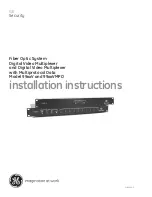
HART Multiplexer System KFD*-HM*-16
Product specification
DO
C
T-0
120D
06/
2014
12
3.2
Description of the HART communication
The HART protocol (
H
ighway
A
ddressable
R
emote
T
ransducer) is supported by
many conventional 4 mA ... 20 mA field devices, which thus enable digital
communication for configuration and servicing purposes. Many device parameters
and also the measured values themselves can thus be digitally transferred to and
from the device. This digital communication runs in parallel with the 4 mA ... 20 mA
signal on the same cable. This is possible through a current modulation, which is
superimposed on the user signal.
Figure 3.3 The modulated HART signal
HART is a Master-Slave protocol: a field device does only respond when requested
(except in "Burst mode"). The message duration is several hundred milliseconds, so
that between two and three messages can be transferred per second.
On HART, there are three groups of commands:
•
The Universal commands; these must be supported by all field devices,
•
the Common practice commands; these are pre-defined commands, suitable for
many field devices, which, if they are supported by the device, must be
implemented in the pre-defined form,
•
device-specific commands; these are commands, which are particularly suitable
for this field device.
The HART Multiplexer contains commands in all three groups. Details of the
supported commands are given in section 9.1.
-0.5 mA
+0.5 mA
0
1200 Hz
2200 Hz
"1"
"0"
20 mA
Analog
signal
C
R
C
R
C
R
4 mA
C = Command
R = Response
Time (seconds)
FSK signal
The high frequency HART signal consists of
the sinusoidal frequencies 1200 Hz and
2200 Hz. This signal has an average value of
zero, so that it does not affect the analog
signal. It is removed by standard analog input
circuit filtering.













































